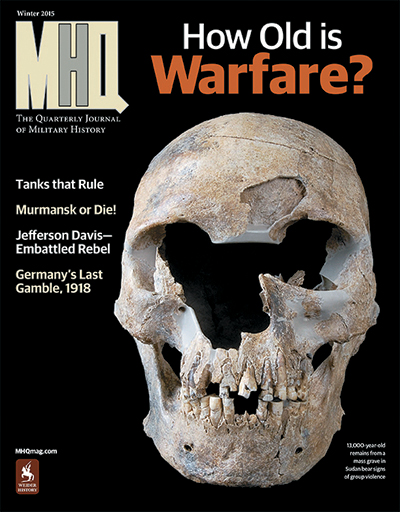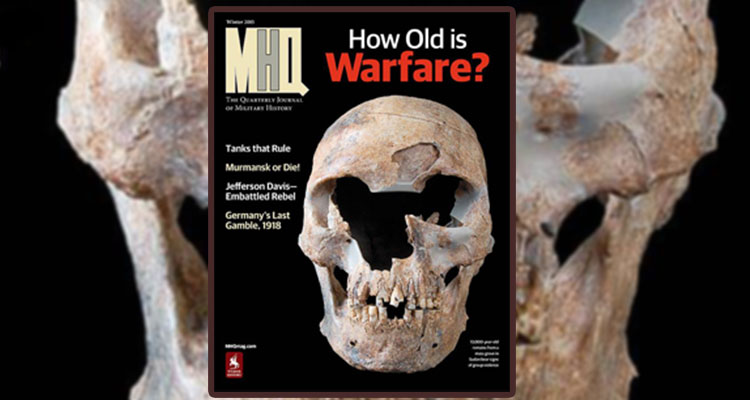
Wayne Lee’s excellent article on the origins of warfare was both intellectually stimulating and a little disquieting for what was omitted and for how things were worded. I drew back my breath when I read Mr. Lee’s words that “this collection of behaviors” (among chimpanzees) is “war” and that it is an “organized group activity….designed to diminish one group for…another.”
“Chimp warfare” is nothing more than the similarly regular activities of a pack of wolves patrolling their territory—just like any other animal, solitary or social, patrolling, swimming, or flying its particular territory for food and mates.
The words “organized group activity” can be interpreted as if there is one alpha male (which there usually is) “selecting” other chimps to go on patrol, “directing” them to attack from left-center-right of position, or having a pre-planned “timing” of assault (e.g., high noon). In no way have the above-quoted concepts been observed as consciously employed in chimpanzee behavior.
Missing from this article is the mention that we almost went extinct 70,000 years ago when the Sumatran Toba volcano created a “nuclear winter.”
Less known is what effect a fused chromosome had on our genes. All the great apes have 24 pairs of chromosomes, except us—we’re the only primate with 23 pairs, with chromosome 2 fused from 2A and 2B. Did that indirectly lead to a bigger brain case, then to cognitive thinking?
Cliff Culpeper
San Francisco, California
Wayne Lee responds: Mr. Culpeper raises some excellent points, several of which I did not have the space to address in my article. They will, however, be covered in my book, Waging War: Conflict, Culture, and Innovation in Human History, to be published later this year. To be clear, I am not arguing for pre-planning or any other sort of culturally evolved group behavior in chimpanzees. The patrolling and other behaviors I referred to evolved at a biological level in order to advance the interests of the group at the expense of other groups. I acknowledge the tremendous ongoing debate about how group behaviors evolve, and, as Mr. Culpeper points out, many species exhibit such behaviors. But I believe it is possible to refer to behavior as “organized” without implying pre-planning (bee and ant behaviors, for example, are organized). My point was not to argue for chimpanzee self-reflection but to suggest that early Homo likely evolved similar behaviors to serve their group dynamics (both internal cooperative and external, intraspecies conflictual). Modern humans are still heirs to that evolutionary process, without being bound by it. As to the role of climate fluctuation, some studies now suggest it may have played a repeated role in narrowing the population level at various stages in the evolution of early Homo.
Christmas box
I was very happy to see the photo in your Winter 2015 issue of a Princess Mary Gift Box. I possess one that has been in my family for 40 years. My late wife, Myrna, was a New Zealander, and the box was handed down to her from her great-uncle Whit Priest, who served with the Anzac troops. I knew very little about the brass box, and I didn’t realize its significance until I read about its history in your issue. It was, indeed, a thrill! Thank you so much.
Charles Eames
Waycross, Georgia
Tank choices
I’m quite confused by the article “Tanks That Mattered,” by Robert Citino. The subtitle says, “In single combat and in wars, these landmark tanks have been arbiters of victory and defeat.” Yet one of those tanks never saw combat (M-1931) and two (S-35 and T-62) were usually on the losing side of combat. The first paragraph states, “Let us turn to the greatest tanks of their time…”—but are these? Since the M-1931 never saw combat, is it included because it was the grandfather of more important tanks? More confusing, the S-35 doesn’t fit either criteria. It had some good points, but with its one-man turret, poor reliability, and high cost–low numbers it made little contribution in battle and led to nothing else.
The T-62 didn’t contribute much in the battle described but was knocked out in large numbers once it ventured beyond the landmark antitank missile defenses. The T-62 wasn’t revolutionary either. Maybe the T-55 would have been a better choice, since it was a groundbreaking design that became the basis for most post–World War II Soviet and Russian tanks, was made in record numbers, and figured in several important conflicts.
Kevin McCue
Spring, Texas
Thanks for a very good and accurate article by Citino—less the evaluation of the M-4 Sherman of World War II as “good enough.”
While the M-4 Sherman, when introduced in North Africa by the Brits against the long-gun Panzer Mark III and the short-gun Mark IV, was certainly good enough at the time, it was not “good enough” for the rest of World War II.
By the end of the North African campaign, as the much-improved Mark VI Tiger I and the Mark V Panther were introduced by the Germans, and indeed even against the long-gunned and improved armored Mark IV, the M-4 Sherman became a death trap. Thin armor, a popgun of a main weapon, and a tendency to burn when hit made it so.
British field marshal Bernard Law Montgomery slaughtered his M-4–equipped Canadian and British armor against a handful of Tigers in front of Caen in a disaster of a campaign in 1944. In the same period, the Americans reckoned that in order for a U.S. Sherman tank company of 17 tanks to get around behind one Tiger or Panther and destroy it from 300 yards with a shot into its rear, it would generally cost that tank company a full platoon of M-4s destroyed by the Tiger or Panther—five American tanks killed to one Tiger; 25 young Americans fried inside their weapons systems trying to knock out one enemy weapons system.
Essentially, the Germans and Russians were able to replace inferior armor weapons systems in their forces during World War II, but the Americans did not. At least the Brits put an efficient armor-defeating 17-pounder gun on their M-4s, thus reducing its vulnerability. The U.S. Army only partially replaced the M-4’s popgun 75s with 76mm guns by May 1945.
The M-4 was most assuredly a tragic failure, and not “good enough.”
Colonel Wayne Long, USA (ret.)
Chester, Maryland
Casting cannons
Thanks for the Revolutionary War cannon foundry map. It’s the first I’ve seen that shows all of the casting sites. Nice work, and a good contribution to history.
Bob Gordon
York, Maine
We welcome your comments. Visit MHQmag.com or e-mail MHQeditor@historynet.com. Letters are edited for length and clarity.


.jpg)



